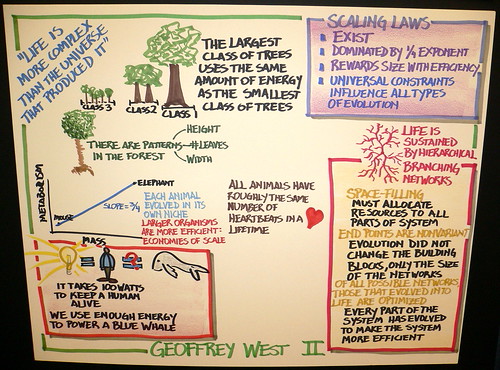Stuff The Internet Says On Scalability For April 20th, 2018
Hey, it's HighScalability time:

Freeman Dyson dissects Geoffrey West's book on universal scaling laws, Scale. (Image: Steve Jurvetson)
If you like this sort of Stuff then please support me on Patreon. And I'd appreciate if you would recommend my new book—Explain the Cloud Like I'm 10—to anyone who needs to understand the cloud (who doesn't?). I think they'll learn a lot, even if they're already familiar with the basics.
- 5x: BPF over iptables; 51.21%: SSL certificates now issued by Let's Encrypt; 15,000x: acceleration from a genomics co-processor on long read assembly; 100 Million: Amazon Prime members; 20 minutes: time it takes a robot to assemble an Ikea chair; 1.7 Tbps: DDoS Attack; 200 Gb/sec: future network fabric speeds; $7: average YouTube earnings per 1000 views; 800 million: viruses cascading onto every square meter of the planet each day; <10m: error in Uber's GPS enhancement; $45 million: total value of Bitcoin ransomware extortion;
- Quotable Quotes:
- @sachinrekhi: Excited to read the latest Amazon shareholder letter. Amazing the scale they are operating at: 100M prime members, $20B AWS business, >50% of products sold from third-party sellers...Bezos Continue reading
 That effort is supported by approximately 1,700 developers, with the carrier pushing around 30 Cloud Foundry updates per day.
That effort is supported by approximately 1,700 developers, with the carrier pushing around 30 Cloud Foundry updates per day.



 An integrated SD-WAN security product would likely involve at least three Cisco technologies: Viptela SD-WAN, Meraki network automation, and Umbrella cloud security.
An integrated SD-WAN security product would likely involve at least three Cisco technologies: Viptela SD-WAN, Meraki network automation, and Umbrella cloud security.
 There are many ways that buyers of Enterprise IT are stupid. Mostly its bad leadership and poor management that leads to poor decisions and processes like ITIL. Sometimes its pride preventing you from admitting failure, or the allure of a free steak lunch (putting one over your salary owner by paying for it with overpriced […]
There are many ways that buyers of Enterprise IT are stupid. Mostly its bad leadership and poor management that leads to poor decisions and processes like ITIL. Sometimes its pride preventing you from admitting failure, or the allure of a free steak lunch (putting one over your salary owner by paying for it with overpriced […]